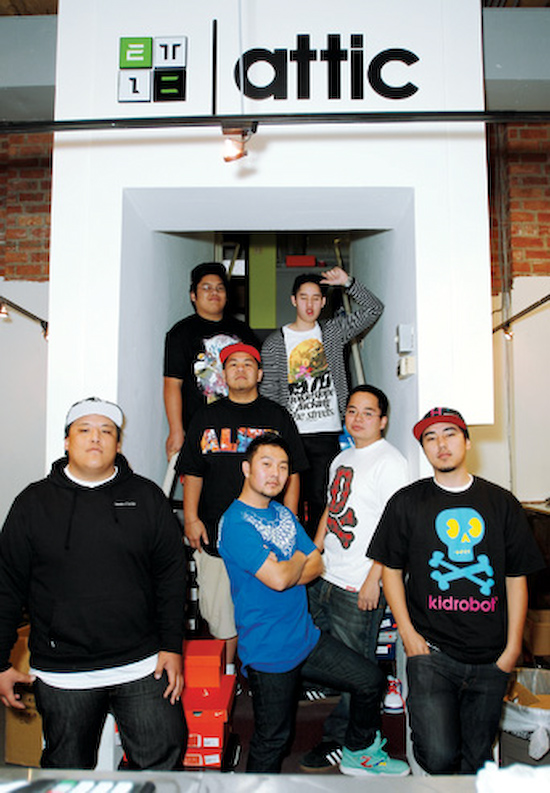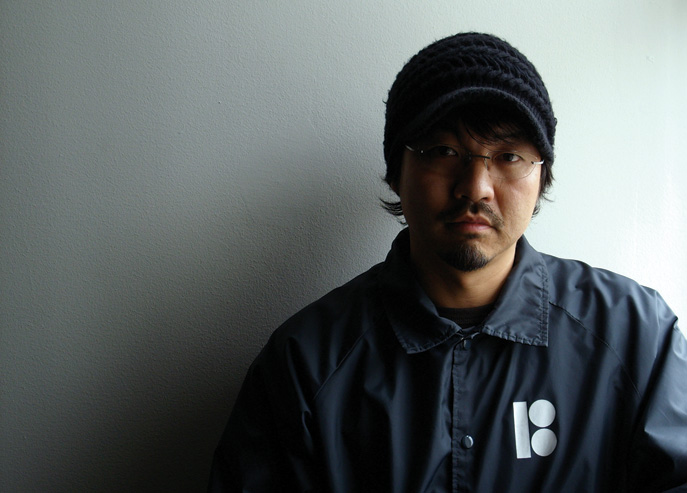By Michelle Woo Photographs by Eric Sueyoshi
The philosophy of streetwear shops is simple: Be exclusive. Be hard to find. And for the love of the brands, stay small.
So when a new streetwear megastore called Attic was about to open, insiders scoffed. “Who are these guys?” they asked.
[ad#336]
James Yang, the store’s co-founder, heard it all. “Nobody likes to be a new guy in a cool guy industry,” the 26-year-old entrepreneur says, standing in the middle of his 8,000-square-foot location in Buena Park, Calif. “When we first opened, some people were like, oh, this is the Wal-Mart of streetwear. We were paying our dues, like in a fraternity.”
But then people discovered the goods. There, behind the automatic glass doors, was a streetwear wonderland: limited-edition sneakers brightly displayed on a mechanical conveyor belt, designer denim packed in pizza boxes and the newest arrivals from lusted-after brands like Crooks & Castles, The Hundreds and Foreign Family. There was even a bar area and a flat-screen TV where customers feet appear when trying on shoes.
Soon, in-the-know hipsters were calling Attic “a streetwear store on steroids,” a description that Yang is much more satisfied with.
Welcome to the brotherhood.
Strolling through Attic, a spacious, industrial-warehouse-like space located just across the street from Knott’s Berry Farm, it’s clear that it’s not like the others. In the business of streetwear, a clothing genre sometimes classified by ’80s pop colors, cartoon-like graphics, flashy vintage footwear and political symbolism, success usually relies on a strict business formula of high-end pricing and limited distribution. As boutiques thrive on a cool-kids-only mentality, bigger is hardly ever better.
But James saw things differently. Having traveled to various streetwear meccas across the globe, he noted that cities like Tokyo offer giant concept stores filled with exclusive goods.
“When people talk about them on the message boards, they’re like, ‘Wow, I wish there were stores like that in the United States.’”
[ad#336]
The story of Attic begins two years ago with a vision, a handshake and a blank check. James’ best friend from childhood is Justin Chon, an actor best known for his role as Tony on Nickelodeon’s “Just Jordan.” After graduating from the University of California, San Diego with a degree in political science, Yang started developing an online store for Justin’s father, Sang, the founder of the athletic footwear chain Mega Shoe Factory. At the same time, for extra cash, Yang was running his own online venture, trading high-end, limited-edition Nikes and other kicks. Sang noticed how much business James was getting on his own and saw an investment opportunity.
James, Justin and Sang joined forces — James and Justin had the streetwear knowledge and Sang had the connections and the pocketbook — and in August 2006, Attic was born in downtown San Diego. The store is located on the top floor of a three-story building and resembles an attic, hence the name.
Attic offered apparel, but the main attraction was the shoes: Lakers-edition Adidas, neon Reeboks, comic-book-print Pumas. Nikes, however, were the best sellers, with styles ranging from faux animal skin to holiday themes. To promote the store, James and the crew would host parties and midnight shoe releases. Customers would wander inside like it was an art show.
“People would come in half-intoxicated and be really excited about the shoes,” he says. “It was a great business model. There’s a mall next door, so why sell ordinary shoes? You’re in downtown. People park their cars to walk around and see something unique.”
Just three months after the San Diego opening, Attic opened its second location in a former crystal factory in Buena Park. Even James was shocked at its size. “When I saw it, I was like, ‘Oh, we’re going to split the store with another business?’ And Sang was like, ‘No, this is all for you.’ I’m just like, sh-t, what the hell am I going to do? I thought it was gonna be chill. I’d just sit at the counter and go on AIM. I was so overwhelmed. He was like, ‘This is going to be the flagship store. I can feel it.’”
The store is divided into sections: West Coast — with brands like Grn Apple Tree, Fresh Jive, Five Four and Playing For Keeps — and East Coast — Lemar and Dauley, Kilo Goods, Upper Playground, Once Upon a Time In NY. There’s even a women’s area, which is rare in what tends to be a boys-only club.
To convince companies to sell their brands at Attic, James had to prove that the merchandise wouldn’t look lost in a dizzying array of products. He had to show companies how he maintains the integrity of each brand through displays.
“It’s not like we stock thousands of pieces of one brand,” James says. “With a bigger store, you’re going to have more diversity. You don’t have to go to multiple stores to pick up the stuff you like. It’s everything on the streets in one.”
[ad#336]
Derek Rhie, 26, is a regular at the Buena Park store. A self-described “Bloomingdales shopper,” he was never into streetwear until visiting Attic about a year ago. One of the things he loves is the customer service.
“You get to go shopping at this cool place but you don’t feel like an outcast if you go in there,” says Rhie, who has gotten compliments, especially from females, on his sweaters, jeans, watches and hats. “The employees know the brands and they know the culture. They want to share that energy with the customers.”
Recently, James and Attic styled the members of the Kaba Modern dance crew, who were finalists on MTV’s “Randy Jackson Presents America’s Best Dance Crew.” He’s working on launching an online store and, in the future, he plans to open another location.
It’s all about thinking big.
[ad#336]





